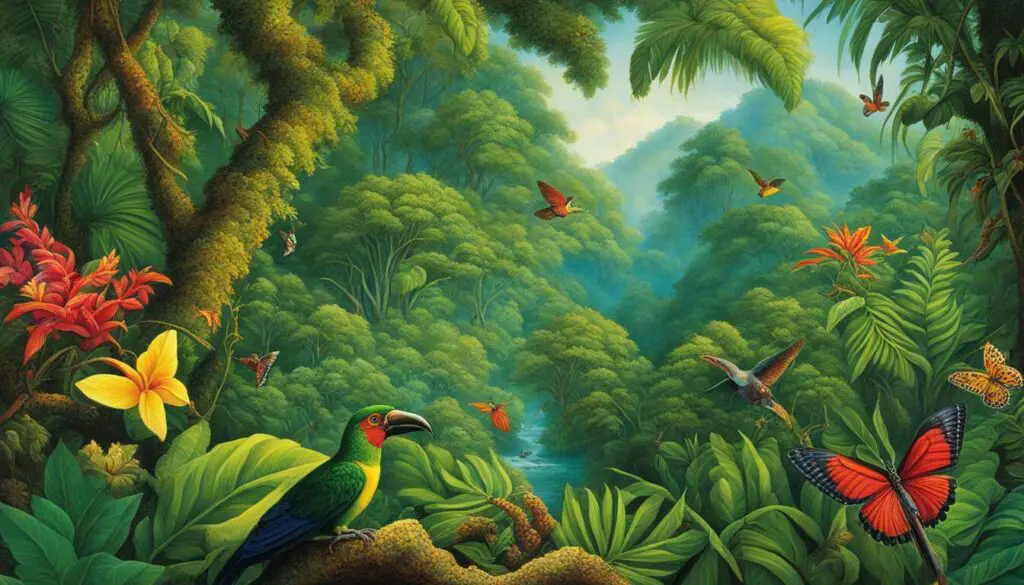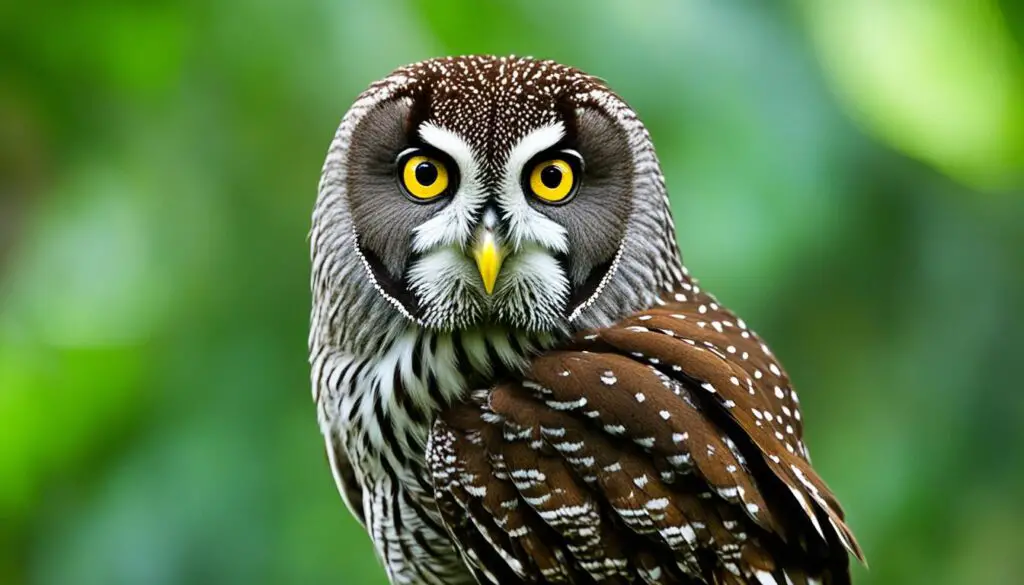Jamaica is a tropical paradise known for its breathtaking beaches, vibrant culture, and reggae music. However, beyond its sun-soaked shores, Jamaica is also home to a remarkable array of animal species. The diverse fauna of Jamaica encompasses mammals, birds, reptiles, and marine life, each contributing to the island’s rich biodiversity.
With its lush forests, crystal-clear waters, and diverse ecosystems, Jamaica provides a habitat for numerous endemic species found nowhere else on Earth. These unique creatures are part of what makes Jamaica’s wildlife so special.

Key Takeaways:
- Jamaica is home to a diverse range of animal species, including endemic ones.
- The island’s fauna consists of mammals, birds, reptiles, and marine life.
- Endangered and extinct species can also be found in Jamaica.
- The conservation of Jamaica’s wildlife is vital for preserving its biodiversity.
- Exploring Jamaica’s wildlife reserves offers unique opportunities to observe and appreciate its fauna.
Mammals of Jamaica: A Look at the Endangered and Extinct Species
Jamaica is home to a variety of mammal species, including endangered, vulnerable, and extinct species. The diverse ecosystem of this Caribbean island supports a range of fascinating mammals that have captured the interest of scientists and conservationists alike.
Endangered Mammals in Jamaica
One of the most captivating creatures found in Jamaica’s coastal waters is the West Indian manatee, also known as the sea cow. These gentle giants are listed as endangered and face threats such as habitat loss, pollution, and boat collisions. Efforts are underway to protect their habitats and raise awareness about the importance of preserving their existence.
The Jamaican rice rat is another endangered mammal species that calls Jamaica’s forests home. These small, nocturnal rodents have a limited distribution and are mainly found in the highlands of the island. Habitat destruction and competition with invasive species pose significant challenges to their survival.
Extinct Mammals in Jamaica
While it is a somber reality, Jamaica has also witnessed the extinction of certain mammal species. One such example is the Jamaican monkey, scientifically known as Xenothrix mcgregori. This primate species was endemic to Jamaica and had a unique adaptation to its environment. Unfortunately, habitat loss and predation by introduced mammals ultimately led to its extinction.
Other Notable Mammal Species
In addition to the endangered and extinct mammals, Jamaica is home to several other notable species. Bats, for instance, play a vital role in maintaining the ecosystem’s balance and are essential pollinators and insect controllers. The island also hosts an introduced species, the mongoose, which was introduced in the 19th century to control rats and snakes but has since become a threat to native wildlife.
Here’s a comprehensive table highlighting some of the mammals found in Jamaica:
| Mammal Species | Status |
|---|---|
| West Indian Manatee | Endangered |
| Jamaican Rice Rat | Endangered |
| Jamaican Monkey (extinct) | Extinct |
| Bats | Varied (includes both endangered and non-endangered species) |
| Mongoose | Introduced (considered a threat to native fauna) |
As Jamaica continues to prioritize conservation efforts, it is crucial to protect the remaining mammal species and work towards the restoration of ecosystems to ensure a harmonious coexistence between humans and wildlife.
Reptiles and Marine Life in Jamaica: Crocodiles and Sea Turtles
Jamaica is a tropical paradise known for its diverse wildlife, including reptiles and marine life. Let’s explore two fascinating species that call this enchanting island home: crocodiles and sea turtles.
Crocodiles in Jamaica
Jamaica is home to a small population of American crocodiles, primarily found along the south coast of the island. These ancient reptiles, once persecuted, are now under protection and slowly recovering in numbers.
With their powerful jaws and prehistoric appearance, crocodiles are both feared and revered. They play a vital role in maintaining the ecological balance of Jamaica’s coastal ecosystems. Observing these majestic creatures in their natural habitat is an awe-inspiring experience.
Sea Turtles in Jamaica
When it comes to marine life, Jamaica is a haven for endangered sea turtles. The most notable species found in the waters surrounding the island is the magnificent leatherback sea turtle.
These gentle giants nest primarily along Jamaica’s north coast, where they make their way ashore at night to lay their precious eggs in the sandy beaches. It’s a magical sight to witness these ancient creatures emerging from the sea and embarking on their journey of motherhood.
To protect these endangered species, certain areas in Jamaica, such as the Oracabessa Bay fish sanctuary, provide safe nesting sites for sea turtles. Visitors can participate in guided turtle-viewing experiences, offering a unique opportunity to witness these magnificent creatures up close while respecting their natural habitat.

Crocodiles and sea turtles are just a glimpse of the incredible reptiles and marine life that thrive in the warm, crystal-clear waters of Jamaica. By preserving their habitats and raising awareness, we can ensure the survival of these magnificent creatures for generations to come.
| Reptiles in Jamaica | Crocodiles | Sea Turtles |
|---|---|---|
| Key Characteristics | Powerful jaws, prehistoric appearance | Majestic, gentle giants |
| Main Location | Primarily found along the south coast | Nesting primarily on the north coast |
| Conservation Status | Protected and slowly recovering | Endangered |
| Protected Areas | No specific protected areas | Oracabessa Bay fish sanctuary |
Birds and Bats in Jamaica: Colorful Avian Species and Unique Flying Mammals
Jamaica is a haven for birdwatchers with its diverse array of avian species. With over 100 recorded species, the island offers a paradise for bird enthusiasts and nature lovers alike. From the majestic Jamaican owl to the captivating barn owl, the vibrant Jamaican parrot, and the delightful hummingbirds, there is an abundance of feathered wonders to observe and appreciate. Whether you explore the lush rainforests, coastal regions, or the Blue Mountains, you are sure to encounter a variety of Jamaican birds in their natural habitat.
“The beauty of birds in Jamaica is truly captivating. The vibrant colors, unique calls, and graceful flight patterns never fail to mesmerize me.” – Avid Birdwatcher
In addition to the rich avian species, Jamaica is also home to a remarkable range of bats, further diversifying its fauna. These flying mammals play a vital ecological role and contribute to the island’s biodiversity. Among the bat species found in Jamaica are the impressive Greater bulldog bat, the Eastern red bat known for its striking coloration, and the Mexican free-tailed bat. Observing these nocturnal creatures in their natural habitat is a fascinating experience that highlights the unique adaptations and behaviors of these flying mammals.
The Importance of Birds and Bats in Jamaica’s Ecosystem
Birds and bats in Jamaica play crucial roles in maintaining the balance of the island’s ecosystem. Birds, with their varied diets and foraging behaviors, assist in pollination and seed dispersal, contributing to the growth and regeneration of plant life. Bats, on the other hand, are valuable for pest control, as they consume large quantities of insects, including agricultural pests.
Birdwatching and bat observation are not only enjoyable hobbies but also provide opportunities for scientific research and conservation efforts. By studying these fascinating creatures, scientists can gain valuable insights into their habitats, migration patterns, and population dynamics, ultimately aiding conservation initiatives to protect these species and their habitats.
| Bird Species | Appearance | Habitat |
|---|---|---|
| Jamaican Owl |  |
Rainforests, woodlands |
| Barn Owl | – | Farmlands, grasslands |
| Jamaican Parrot | – | Forests, mountainous regions |
| Hummingbirds | – | Flower-rich areas |
As for bats, these fascinating mammals have adapted to various habitats across Jamaica, including caves, forests, and even urban areas. Their ability to navigate using echolocation and their unique role as pollinators and seed dispersers make them indispensable to the ecosystem.
By appreciating and conserving birds and bats in Jamaica, we play a crucial role in protecting the island’s natural heritage and ensuring the continued existence of these remarkable creatures for future generations to admire and study.
Conclusion: Jamaica’s Rich Wildlife and Conservation Efforts
Jamaica is renowned for its remarkable biodiversity and diverse range of animal species. From the majestic West Indian manatee to the enchanting Jamaican parrot, the island is a treasure trove of unique fauna. To safeguard this precious wildlife, Jamaica has implemented various conservation efforts and established wildlife reserves. These initiatives aim to protect the natural habitats of animals and ensure the preservation of their species for future generations.
One such example is the Black River Safari located on the south coast of Jamaica. This mesmerizing safari allows visitors to observe crocodiles in their natural habitat, while also raising awareness about the importance of preserving these magnificent creatures. Additionally, the Seven Oaks Sanctuary for Wildlife provides a sanctuary for threatened and endangered species, serving as a haven for their rehabilitation and protection.
Jamaica’s commitment to conservation extends to its marine ecosystems as well. The island boasts stunning nesting sites for endangered sea turtles, particularly on its north coast. By supporting sea turtle conservation efforts and participating in turtle-viewing experiences, visitors can play an active role in preserving these incredible creatures for generations to come.
In conclusion, Jamaica’s rich wildlife and conservation efforts make it a must-visit destination for nature enthusiasts. By appreciating and respecting the natural habitats of these animals and supporting conservation initiatives, we can ensure the continued survival and flourishing of Jamaica’s unique flora and fauna.
FAQ
What are some notable animals found in Jamaica?
Some notable animals found in Jamaica include the West Indian manatee, Jamaican monkey, Jamaican rice rat, bats, crocodiles, mongoose, and sea turtles.
Are there any endangered mammal species in Jamaica?
Yes, there are several endangered mammal species in Jamaica, including the West Indian manatee, Jamaican monkey, and Jamaican rice rat.
Are there any extinct mammal species in Jamaica?
Yes, the Jamaican monkey, also known as Xenothrix mcgregori, is an extinct primate species that was only found in Jamaica.
What reptile species can be found in Jamaica?
Jamaica is home to a small population of American crocodiles, mainly found on the south coast of the island.
Are sea turtles found in Jamaica?
Yes, Jamaica is home to endangered sea turtles, including the leatherback sea turtle, which primarily nests on the north coast of the island.
How many bird species can be found in Jamaica?
Over 100 bird species have been recorded on the island of Jamaica, including the Jamaican owl, barn owl, Jamaican parrot, and various species of hummingbirds.
Are there any bats in Jamaica?
Yes, Jamaica is home to a diverse range of bats, including the Greater bulldog bat, Eastern red bat, and Mexican free-tailed bat.
What conservation efforts are being made in Jamaica?
Efforts are being made to protect and conserve Jamaica’s wildlife, including the establishment of wildlife reserves and ongoing conservation programs.
